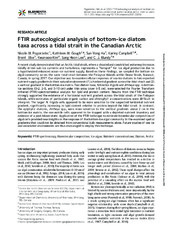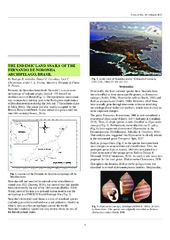Artikler, rapporter og annet (arktisk og marin biologi): Nye registreringer
Viser treff 341-360 av 1637
-
Environmental niche overlap in sibling planktonic species Calanus finmarchicus and C. glacialis in Arctic fjords
(Journal article; Tidsskriftartikkel; Peer reviewed, 2022-12-08)Knowledge of environmental preferences of the key planktonic species, such as Calanus copepods in the Arctic, is crucial to understand ecosystem function and its future under climate change. Here, we assessed the environmental conditions influencing the development stages of Atlantic Calanus finmarchicus and Arctic Calanus glacialis, and we quantified the extent to which their niches overlap by ... -
Inverse method applied to autonomous broadband hydroacoustic survey detects higher densities of zooplankton in near-surface aggregations than vessel-based net survey
(Journal article; Tidsskriftartikkel; Peer reviewed, 2022-11-10)Throughout all oceans, aggregations of zooplankton and ichthyoplankton appear as horizontal sound scattering layers (SSLs) when detected with active acoustic techniques. Quantifying the composition and density of these layers is prone to sampling biases. We conducted a net and trawl survey of the epipelagic fauna in northern Norway (70˚N) in June 2018 while an autonomous surface vehicle equipped ... -
What is a fish? The life and legend of David L.G. Noakes
(Journal article; Tidsskriftartikkel; Peer reviewed, 2022-10-17)David Lloyd George Noakes (1942–2020) is best known for his insatiable curiosity, his quick wit and dry sense of humor, his scientific contributions to the field of animal behaviour, and his ability to form and maintain long-lasting connections. His research interests were vast but remained grounded in early life history, behaviour, social behaviour, the evolution of behaviour, behavioural genetics, ... -
Changes in humpback whale song structure and complexity reveal a rapid evolution on a feeding ground in Northern Norway
(Journal article; Tidsskriftartikkel; Peer reviewed, 2022-12-09)Singing behaviour by male humpback whales (Megaptera novaeangliae) has traditionally been associated with low-latitude breeding grounds. However, in recent years, this vocal behaviour has been increasingly reported outside these areas. All singers in a given population sing the same version of a song and this song is continually evolving over time with modifications on different levels within the ... -
FTIR autecological analysis of bottom-ice diatom taxa across a tidal strait in the Canadian Arctic
(Journal article; Tidsskriftartikkel; Peer reviewed, 2022-12-23)A recent study demonstrated that an Arctic tidal strait, where a shoaled and constricted waterway increases tidally driven sub-ice currents and turbulence, represents a “hotspot” for ice algal production due to a hypothesized enhanced ocean-ice nutrient supply. Based on these findings, we sampled the bottom-ice algal community across the same tidal strait between the Finlayson Islands within Dease ... -
Pharmacokinetics of a long-acting subcutaneous eprinomectin injection in semi-domesticated reindeer (Rangifer tarandus tarandus) - a pilot study
(Journal article; Tidsskriftartikkel; Peer reviewed, 2022-12-17)Reindeer (Rangifer tarandus tarandus) are exposed to the pathogenic parasitic nematode Elaphostrongylus rangiferi during grazing. The severity of disease is dose-dependent. Prophylactic anthelmintic treatment is needed to improve animal health and reindeer herding sustainability. Herds are traditionally only gathered once during the summer, requiring a drug with a persistent effect. In this study ... -
Klimaendringer og virkninger på hovedøkosystem skog.
(Research report; Forskningsrapport, 2022-04-29) -
Age class composition and growth of Atlantic cod (Gadus morhua) in the shallow water zone of Kongsfjorden, Svalbard
(Journal article; Tidsskriftartikkel; Peer reviewed, 2022-12-26)Although Atlantic cod has been observed in Svalbard waters since the 1880s, knowledge about the presence in the Arctic shallow water zone is limited. The regular catch of juvenile Atlantic cod in Kongs orden since 2008 is in line with an overall northward shift of boreal fish species toward the Arctic. This is the first study showing the age class composition, growth rates, and stomach content ... -
Blowing in the Wind: Using a Consumer Drone for the Collection of Humpback Whale (Megaptera novaeangliae) Blow Samples during the Arctic Polar Nights
(Journal article; Tidsskriftartikkel; Peer reviewed, 2023-12-26)Abstract Analysis of cetacean blow offers a unique potential for non-invasive assessments of their health. In recent years, the use of uncrewed aerial vehicles (UAVs) has revolutionized the way these samples are collected. However, the high cost and expertise associated with purpose-built waterproof UAVs, paired with the challenges of operating during difficult meteorological conditions, can be ... -
Vertical redistribution of principle water masses on the Northeast Greenland Shelf
(Journal article; Tidsskriftartikkel; Peer reviewed, 2022-12-10)The Northeast Greenland shelf (NEGS) is a recipient of Polar Water (PW) from the Arctic Ocean, Greenland Ice Sheet melt, and Atlantic Water (AW). Here, we compile hydrographical measurements to quantify long-term changes in fjords and coastal waters. We find a profound change in the vertical distribution of water masses, with AW shoaling >60 m and PW thinning >50 m since early 2000’s. The properties ... -
Plant defense under Arctic light conditions: Can plants withstand invading pests?
(Journal article; Tidsskriftartikkel; Peer reviewed, 2022-11-24)Global warming is predicted to change the growth conditions for plants and crops in regions at high latitudes (>60° N), including the Arctic. This will be accompanied by alterations in the composition of natural plant and pest communities, as herbivorous arthropods will invade these regions as well. Interactions between previously non-overlapping species may occur and cause new challenges to herbivore ... -
Using camera traps to monitor cyclic vole populations
(Journal article; Tidsskriftartikkel; Peer reviewed, 2022-12-02)Camera traps have become popular labor-efficient and non-invasive tools to study animal populations. The use of camera trap methods has largely focused on large animals and/or animals with identifiable features, with less attention being paid to small mammals, including rodents. Here we investigate the suitability of camera-trap-based abundance indices to monitor population dynamics in two species ... -
Semantic Segmentation in Underwater Ship Inspections: Benchmark and Dataset
(Journal article; Tidsskriftartikkel; Peer reviewed, 2022-12-23)In this article, we present the first large-scale data set for underwater ship lifecycle inspection, analysis and condition information (LIACI). It contains 1893 images with pixel annotations for ten object categories: defects, corrosion, paint peel, marine growth, sea chest gratings, overboard valves, propeller, anodes, bilge keel and ship hull. The images have been collected during underwater ... -
A stream-to-sea experiment reveals inhibitory effects of freshwater residency on organic-matter decomposition in the sea
(Journal article; Tidsskriftartikkel; Peer reviewed, 2022-05-17)One billion tons of carbon are annually transported to the global ocean, and the fate of this carbon hinges not only on marine processing rates, but also on freshwater processing during downstream transport. Using a cotton-strip assay, we assessed the decomposition of organic matter in marine and freshwater sites and simulated its downstream transport from freshwater to the sea by translocating ... -
Behavioural responses of wild anadromous Arctic char experimentally infested in situ with salmon lice
(Journal article; Tidsskriftartikkel; Peer reviewed, 2022-06-24)Salmon lice can impact the marine behaviour, growth, and survival of salmonids, but little is known about their effects on Arctic char. We present behavioural responses from the first dose-response experiment with wild anadromous Arctic char (n = 50) infested in situ with salmon lice (0.0–1.2 lice g<sup>−1</sup> fish) in an area with low natural infestations. Infested fish spent less time at sea ... -
Uptake of sympagic organic carbon by the Barents Sea benthos linked to sea ice seasonality
(Journal article; Tidsskriftartikkel; Peer reviewed, 2022-11-11)On Arctic shelves, where primary production occurs in both the pelagic and sympagic (ice-associated) habitats, sympagic organic material (OM) can constitute a disproportionate fraction of benthic diets due to higher sinking rates and lower grazing pressure than pelagic OM. Less documented is how sympagic OM assimilation across feeding guilds varies seasonally and in relation to sea ice duation. We ... -
Light and freshwater discharge drive the biogeochemistry and microbial ecology in a sub-Arctic fjord over the Polar night
(Journal article; Tidsskriftartikkel; Peer reviewed, 2022-09-30)The polar night has recently received increased attention as a surprisingly active biological season. Yet, polar night microbial ecology is a vastly understudied field. To identify the physical and biogeochemical parameters driving microbial activity over the dark season, we studied a sub-Arctic fjord system in northern Norway from autumn to early spring with detailed monthly sampling. We focused ... -
Predation research with electronic tagging
(Journal article; Tidsskriftartikkel; Peer reviewed, 2022-12-15)Predation is a fundamental aspect of ecology that drives ecosystem structure and function. A better understanding of predation can be facilitated by using electronic tags that log or transmit positions of predator or prey species in natural settings, however, there are special considerations that must be made to avoid biased estimates. We provide an overview of the tools available for studying ... -
Genome-Wide Identification and Expression Analysis of SnRK2 Gene Family in Dormant Vegetative Buds of Liriodendron chinense in Response to Abscisic Acid, Chilling, and Photoperiod
(Journal article; Tidsskriftartikkel; Peer reviewed, 2022-07-22)Protein kinases play an essential role in plants’ responses to environmental stress signals. SnRK2 (sucrose non-fermenting 1-related protein kinase 2) is a plant-specific protein kinase that plays a crucial role in abscisic acid and abiotic stress responses in some model plant species. In apple, corn, rice, pepper, grapevine, Arabidopsis thaliana, potato, and tomato, a genome-wide study of the ... -
The endemic land snails of the Fernando de Archipelago, Brasil
(Journal article; Tidsskriftartikkel, 2022)Fernando de Noronha (henceforth ‘Noronha’) is an oceanic archipelago of volcanic origin, located ~350 km off the northeast coast of Brasil (Fig. 1). The eponymous main island was an important midway port in the Portuguese exploitation of Brasilian resources during the 16th and 17th centuries (Lins & Silva, 2013). The island was also briefly occupied by the British, French and Dutch. It also ...


 English
English norsk
norsk


















